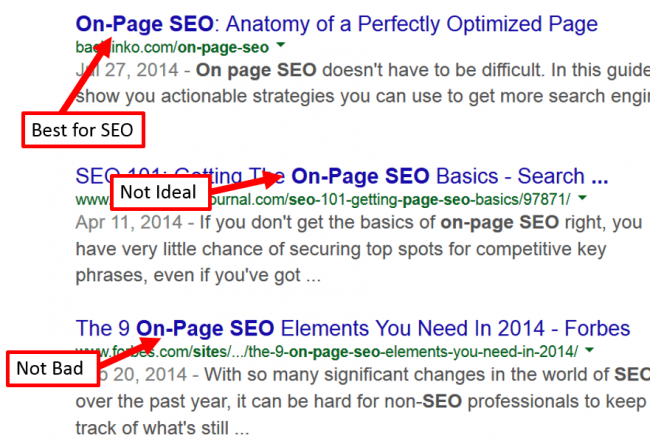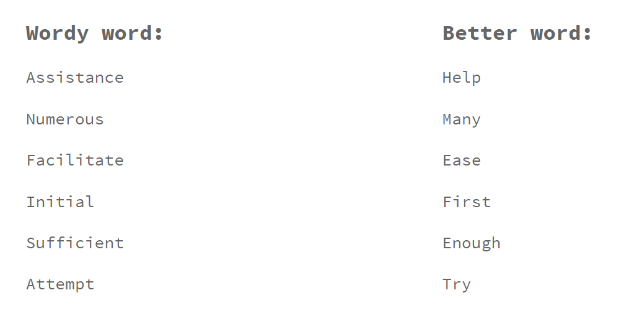
Having a professional business website that conveys a strong message can prove to be a great leads or sales generating tool. However, the key here is to convey the right message, one that helps you connect to your target audience at a higher level. Which is why investing in good SEO friendly content is essential.
The purpose of creating quality content is not just to make your business site look good. You want the right people to read what you are writing. And that means your content also needs to rank higher in the search engine result pages. Because it’s a proven way to reach out a bigger section of your target audience.
Since people are regularly searching for topics relevant to your business (regardless of the industry you are in), you don’t just need content, you need content that impresses both — the readers and the search engines. In short, you need in-depth, SEO friendly content that ranks in the top ten search results.
Creating quality content is important when it comes to creating a quality impression on your readers. But without focusing on the SEO aspect of it, you’re missing out on the chances to getting your content in front of the right people.
Keep in mind that good content goes hand in hand with ethical SEO, so it’s something that every business (no matter how small) needs to work on.
Is producing SEO friendly content hard? Of course not. If you’re already creating content, you just need to take it a notch up in the right direction if you want to reap the benefits of SEO.
Once you start working on producing great, SEO friendly content, it not only gets easier to achieve higher search engine rankings, but also gets simpler to keep your position in the search engine result pages.
So the question is, how do you really go about creating SEO friendly content that actually gets real-world results? What do you need to ensure you’re doing better than your competitors in terms of producing content that is favored by Google and its users?
In the following article we’ll be looking into 5 essential rules that you can follow to make your content more SEO friendly, without breaking any of the white hat SEO rules.
5 Cardinal Rules on How to Create SEO Friendly Content
Rule #1: Take an Original Approach
Creating SEO friendly content in itself doesn’t have to be a daunting task. But the moment you try to copy others it becomes difficult. When you focus on being authentic and different in your own way, without focusing too much on your competitors, you have a much better chance of creating new content that really matters.
Standing out of the crowd gets a lot more achievable when your content is authentic and original. Now, this doesn’t mean that you cannot seek inspiration from sources within your industry. You always can learn from others before offering your own unique insight.
So if that’s the case, why are more than half of the brands out there failing when it comes to creating authentic content? The answer may not be so simple.

When you’re focusing on creating real, SEO friendly content, forget rehashing what has already been overly done. Being original is what really matters and that can only happen when you bring out the originality in the concepts or ideas that you share. Avoid taking the lazy route with your content. Instead, make it a piece worth consuming and sharing. Make it a breath of fresh air.
One of the key aspects to improving search engine optimization results is get other reputable websites within your niche to link to yours. When you put in real effort to make your content original, you automatically open doors for building more backlinks. Because quality websites like to link to helpful resources that offer something new and authentic.
If you look at the stats, 90% of consumers find custom content (read: unique) helpful and almost 80% believe in a company that is working on strengthening its relationship with them.
Also, looking at it purely from Google’s point of view, you will get rewarded by the big G for publishing original content in terms of higher ranking. And get penalized for any content that is blatantly copied from somewhere else.
You can make your content more original and SEO friendly by…
A) Tapping Into Your Reader’s Emotions
A simple yet proven way to make your content original that helps you connect with your target audience is to focus on touching their emotions.
In fact, it has been found that a marketing message becomes 2X more effective when it impresses the reader’s emotions and gives them a reason to share. Whether your content is humorous or controversial, if it can stir the right emotions, it has a higher chance of standing out in the crowd.
Here are three ways you can evoke the emotions of your readers and boost the chances of gaining traction/engagement from each piece of content you produce.
- Use the right kind of vocabulary that has a positive and uplifting effect on readers. The idea is to make them feel more confident, inspired and even intelligent with your words.
- Inspire your readers to take action by sharing your content with others. Use storytelling as a tool to create inspirational content that is worth sharing with others. For instance, you can share one of your customer’s success story and make your content both, authentic and inspiring, ultimately making it more SEO friendly.
- Keep your readers interested by surprising them with unexpected twists and turns, without losing focus on the main topic.
B) Adding Your Own Perspective
There is a sea of content on the Internet, so what will make people choose your piece of content over your competitors? It’s because of the value you bring and how you add your own twist/angle to the content. Your unique perspective can make your content notable and SEO friendly.
One of the best ways to do this is to share your own experience with what you’re discussing. Do you have a personal story or anecdote that can shed light on the topic? Do you have a unique solution to share for a common problem?
Sharing a personal story with your readers adds an air of authenticity to your content and also humanizes it. It helps bring about a positive change in each reader. It makes your content marketing efforts truly pay off.
Rule #2: Choose the Right Keywords
Selecting the right keyword can be seen as one of the most crucial steps towards creating quality SEO friendly content. The idea is to choose a keyword that’s worth targeting and weave it into an strong piece of content so you’re able to rank for it above your competitors. However, when not executed correctly, your keyword usage can backfire. Which is why it requires careful consideration.
Your target keyword could range from a two-word keyword to a five-word phrase that represents your article’s main topic. Even though your article will end up ranking for multiple keyword phrases, it’s worth targeting a specific keyword that conveys your topic vividly. This is usually the keyword that you want your article to rank high for.
Here are the steps that you can take to choose and use the most appropriate keywords for your content.
Consider Your Main Topic
The foundation of any kind of keyword research is to know your topic inside out. You need to get into the specifics of the topic you are targeting and understand what it has to offer to the readers. What kind of solution does it provide?
Brainstorm Your List of Preferred Keywords
There are a number of keyword research tools out there, but the one that you need to start with is your own mind. Put yourself into the searcher’s shoes and ask yourself, what search query would you use if you were searching for your target topic?
Make a list of all the keyword phrases that come to your mind. Here’s an example.
Start Your Keyword Research Process
Once you have your list of keywords, log on to the Google Keyword Planner tool to begin your research. Since this tool is free and effective, it can give you the head start you need.
Open the Google Keyword Planner tool and enter your choice of keyword phrase (from your list) into the “Word or Phrase” box. This should give you the global monthly search volume for the keyword phrases you searched for, along with the data for related phrases. Try to only look for keyword phrases that are “natural language” because it’ll be easy to include them in your headlines and content.
Avoid High Search Volume Keywords
It can be tempting to choose keywords that have a high global search volume. But it’s a good idea to avoid these phrases because given their popularity, they’ll be hard to rank for.
It’s better to hit the page one for a keyword that gets a 1,000 monthly searches than a keyword with a much higher search volume where you have no chance of beating the competitors.
There is no hard and fast rule when it comes to choosing keywords based on search volume. What you really need to focus on is going for keyword phrases that are highly relevant to your topic and then see if it would be worth targeting them. Only spend time on keyword phrases that you can realistically rank for.
Go for Long Tail Keyword Phrases
Time and again, it has been proven that some of the best performing keywords in terms of quality do not have a high search volume.
These long tail keyword phrases are more specific when compared to their shorter counterparts. But they are totally worth targeting because searchers using them are more sure of what they want. They’re simply focused, and in many cases, are in the “buying mode”.
People that use short and broad keyword phrases have a vague idea of what they want. They’re researching and learning, which means their chances of them “converting” are low.However, when someone use a longer keywords (many times in the form of a question), they are much likely to take action. Which could be anything from sharing your article, joining your email list or simply hitting the buy button.
Rule #3: Effectively Optimize Your Titles
When people hit Google to search something, they are often faced with a number of options on first page. A quick glance through the top ten results, they decide on visiting the websites with the most enticing headlines.
That’s right, the headline or the title of your page is the first thing a search user will notice. If it entices them, they click through and visit the site. If not, they move on. You want to be the site they visit, not ignore.
Creating SEO friendly content is not just about puand the information you share. No, it’s also about creating a great title for your page that gives people a reason to visit your site.
There are two things that you can do right away to make your headline worth clicking:
1. Brainstorm Variations: Coming up with a great headline can be difficult if you’re trying to get it right in the first attempt. Rarely do you find a worthy title that way. Instead, what you need to do is brainstorm with your colleagues or partners a number of headline variations for the page.
Your aim is to find the one that truly resonates with your target audience. It’s not uncommon to go through 20 or even 30 headline variations before you find the best one.
2. Use Keywords Naturally: Using your focus keyword in your headline, especially in the beginning of it, is great for SEO. However, the last thing you want to do is sound forced. Try to weave in your keyword in the headline in a way that gives meaning to it, instead of making it sound robotic.

You can couple up your focus keyword with power words – big, best, improve, etc. to make it look more natural and attractive. Keep it short (less than 60 characters) and see to it that is is zero redundancy. Your title should pack a punch and also make sense at the same time.
Rule #4: Aim for Better Content Readability
Content readability is nothing but how easy it is to understand a certain written text. When creating SEO friendly content, it’s important to not miss out on the readability factor. While you are busy optimizing your content for the right keywords, its readability may go for a toss, which is a strict no-no.
Even though content readability isn’t seen as a direct Google ranking factor, it is definitely an indirect one and can affect your SEO initiative.
It’s also important to note that there are many different algorithms specifically created to understand how readable a piece of content is, which the search engines may use. A popular and effective content readability calculating algorithm is the Flesch-Kincaid readability score.

- Use Simple Vocabulary

One of the easiest ways to enhance your content readability score and make it SEO friendly is to use simple words that your readers can connect with. Say goodbye to any type of jargon where you have to use long, complex words.
Use shorter words that add meaning to your content but don’t confuse the readers. Give them the information they want in the easiest to understand manner. Period.
- Make Your Sentences Short
Longer sentences are not only hard and confusing to understand, but they’re also difficult to write while making sense. Make your sentences shorter wherever you can. Break down a long sentence into several shorter, easy-to-digest sentences. No wonder famous writer Ernest Hemingway was a fan of shorter sentences.
- Write Like You Talk
When it comes to creating easy to understand, SEO friendly content, your tone matters a lot. If you can write in a conversational tone, you’ll automatically make your overall content simple and to the point.
Even though this isn’t a rule that’s etched in stone, it does help to make your content more reader friendly. Also, writing like you are talking to a friend is much easier and more natural.
- Format Properly
Shorter paragraphs make a lot more sense when you are writing for the web where people do not like big blocks of text. When it comes to proper formatting, using more and more white space will only make your content appealing and more SEO friendly.How often should you separate your sentences into paragraphs? The answer is whenever you can.
Also, break down your text using subheadings along with bullet points and tables. The idea is to present your content in a more readable or digestible manner. Remember, content that is easy on the eyes gets read and spread.
- Proofreading is the key
No matter how great, how informational or how well- researched your article may be, if the content is full of misspelled words and grammatical errors, no one would surely read it. All the elements above will be pointless if you will not be able to proofread your post.
So if you have an editor, be sure to let them check the article first before publishing. But if you don’t have one, then there are several online tools that can help you with this task such as the Hemingway Editor and Grammarly.
5. Add Relevant Images
Good content readability and a good choice of images, both go hand in hand. Because images basically help you add excitement to “only text” which can look boring and monotonous. Try to use relevant images wherever you feel applicable in your content in order to segment it better.
While it is encouraged that you add an image to your content as often as you can, research says that the best image to text ratio is one image for every hundred words.
Don’t add images to your content just for the sake of adding them. Your readers should be able to derive some value out of them. The more relevant an image is to the content, the better your audience will be able to connect to it.
Rule #5: Focus on Improving User Experience
User experience or UX is one of the key factors when it comes to the success of a website. Which is why UX focused marketing is important. And it is not limited to the overall website design. It goes beyond that and extends to how you use content on your site and the way it impacts its experience.
Creating content that just fills up space on your website won’t take you far. Every piece of content that you create should start with your target user in the forefront. Keep your readers in your mind, even when your trying to improve your site’s SEO.
Can you write content or even research keywords without understanding or knowing your target audience? Of course not. Because that’s a recipe to failure.
Before you start on your “content creation” tasks, ask yourself…
- What do my readers want from me? What is the expectation of my audience?
- How can I create content that adds to the website’s overall user experience and improves it?
- Does my website’s core values help my content marketing strategy or hurts it?
The closer you take a look at your website and the kind of content you’re publishing, the easier it will be for you to serve your target audience. And Google knows this, which is why you’ll find websites that offer a stellar user experience are almost always rewarded by the search engine giant.
Here’s what your information architecture should be like…
So in order to increase the chances of making your content SEO friendly, see to it that you…
- Keep Users in the Forefront
If you want to create SEO friendly that works, you need to think users first. Your content strategy should be designed around the user, not the other way round. Users, along with context and content should make up your site’s core information architecture.So, next time, don’t start off by thinking what you would want to cover in your blog post or eBook. Instead, focus on what type of ideas or solutions your users want or need from a business like yours. Produce true SEO friendly content that gives your readers value in every possible way. - Grab their Attention Early On
In order to catch the attention of your readers and keep it that way, don’t create content without having a central theme for it. Every piece of SEO friendly content has a certain theme that it is written around.
Why? Because you want readers to know what to expect right from the start. You want them to have clarity. Even if your content has the best and the most relevant information, it’ll fail to give results if it doesn’t deliver in the first few moments.
Wrapping Up
As you can probably tell by now SEO and content marketing are pretty much a two in one type venture. If you’re going to perfect one, you should probably perfect the other as well or your time won’t be very well spent. They complement each other and don’t work as well without the help of each other.









More Stories
Best Ideas for Content Marketing for Financial Advisors
4 Content Optimization Tips to Help Your Business Stand Out